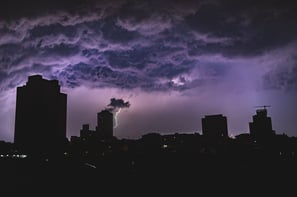Can your business survive a natural disaster? Many don't. More than 30 percent of businesses never reopen their doors after they've been closed down by a hurricane, tornado, flood, or other devastating calamity. A disaster recovery plan and adequate insurance are keys to getting back to business, say the Insurance Information Institute and the Institute for Business & Home Safety.
Your insurance plan should consider:
Understand your policy and deductibles and limits. Speak with your insurance agent or company representative to make sure you know what kind of coverage you have.
Have sufficient coverage to pay for the indirect costs of the disaster. Coverage should include the disruption to your business, as well as the costs of rebuilding.
Evaluate your property insurance policy. Insure any improvements you've made the property. There may be limitations on what the policy will pay for certain items. If you need higher amounts, discuss this with your agent.
Consider flood or earthquake insurance. Typical property insurance policies exclude coverage for flood or earthquake damage. If you're located in a flood zone, you'll probably have to buy a separate policy from the National Flood Insurance Program (NFIP).
Protect yourself against business interruption. Business interruption insurance covers the profits a business would have earned, based on its own records, had the disaster not occurred. It also pays for the operating expenses that continue, such as payroll, even though the business activities come to a temporary halt.
Include extra expense insurance. Extra expense insurance reimburses you for what you spend, over and above your normal operating expenses, to avoid having to shut down during the restoration period.
Leave no gaps in your insurance. Insurance policies should include property, business interruption, and extra expense insurance. Even if your basic policy covers expenses and loss of net business income, it may not cover income interruptions due to damage that occurs away from your premises, such as to your key customer or supplier or to your utility company.
Develop a disaster recovery plan.
A business impact analysis should be developed to identify what an operation must do to protect itself in the face of a natural disaster. Large corporations often hire risk managers to handle this task and some companies hire consultants with expertise in disaster planning and recovery to assist them with their plans. But small businesses can do the analysis and planning on their own.
Your business disaster plan:
Set up an emergency response plan and train employees to carry it out. Make sure employees know who to notify about the disaster and what measures to take to preserve life and limit property losses.
Write out each step of the plan and assign responsibilities to employees in clear and simple language. Practice the procedures set out in the emergency response plan with regular, scheduled drills.
Compile a list of important phone numbers and addresses. Make sure you can get in touch with key people after the disaster. The list should include local and state emergency management agencies, major clients, contractors, suppliers, realtors, financial institutions, insurance agents, and insurance company claim representatives.
Decide on a communication strategy to prevent loss of customers. Post notices outside your premises; contact clients by phone, email, or regular mail; place a notice in the local newspapers.
Consider the things you may need initially during the emergency. Do you need a back-up source of power? Do you have a back-up communications system?
Human resources. Protect employees and customers from injury on the premises. Consider the possible impact a disaster will have on your employees' ability to return to work and how customers can return to shop or receive goods or services.
Physical resources. Inspect your business' physical plant(s) and assess the impact a disaster would have on facilities. Make sure your plans conform to local building code requirements.
Business continuity. Even if your business escapes a disaster, there is still a risk that the business could suffer significant losses due to the inability of suppliers to deliver goods or services or a reduction in customers. Businesses should communicate with their suppliers and markets (especially if they are selling to a business as a supplier) about their disaster preparedness and recovery plans, so that everyone is prepared.
Protect your building. If you own the structure that houses your business, integrate into your plan disaster protection for the building and the contents. Consider the financial impact if your business shuts down as a result of the disaster. What would be the impact for a day, a week, or an entire revenue period?
Keep duplicate records. Back up computerized data files regularly and store them off-premises. Keep copies of important records and documents in a safe deposit box and make sure they're up to date.
Identify critical business activities and the resources to support them. If you cannot afford to shut down your operations temporarily, determine what you need to run the business elsewhere.
Find alternative facilities, equipment and supplies, and locate qualified contractors. Consider a reciprocity agreement with another business. Try to get an advance commitment from at least one contractor to respond to your needs.
Protect computer systems and data. Data storage firms offer off-site backups of computer data that can be updated regularly.
This article is intended for general educational and illustrative purposes only and should not be construed to communicate legal or professional advice. Further, this article is not an offer to sell insurance. Please consult with your licensed insurance agent for specific coverage details and your insurance eligibility. All policies are subject to the terms, conditions, limitations, definitions, and exclusions contained therein.




